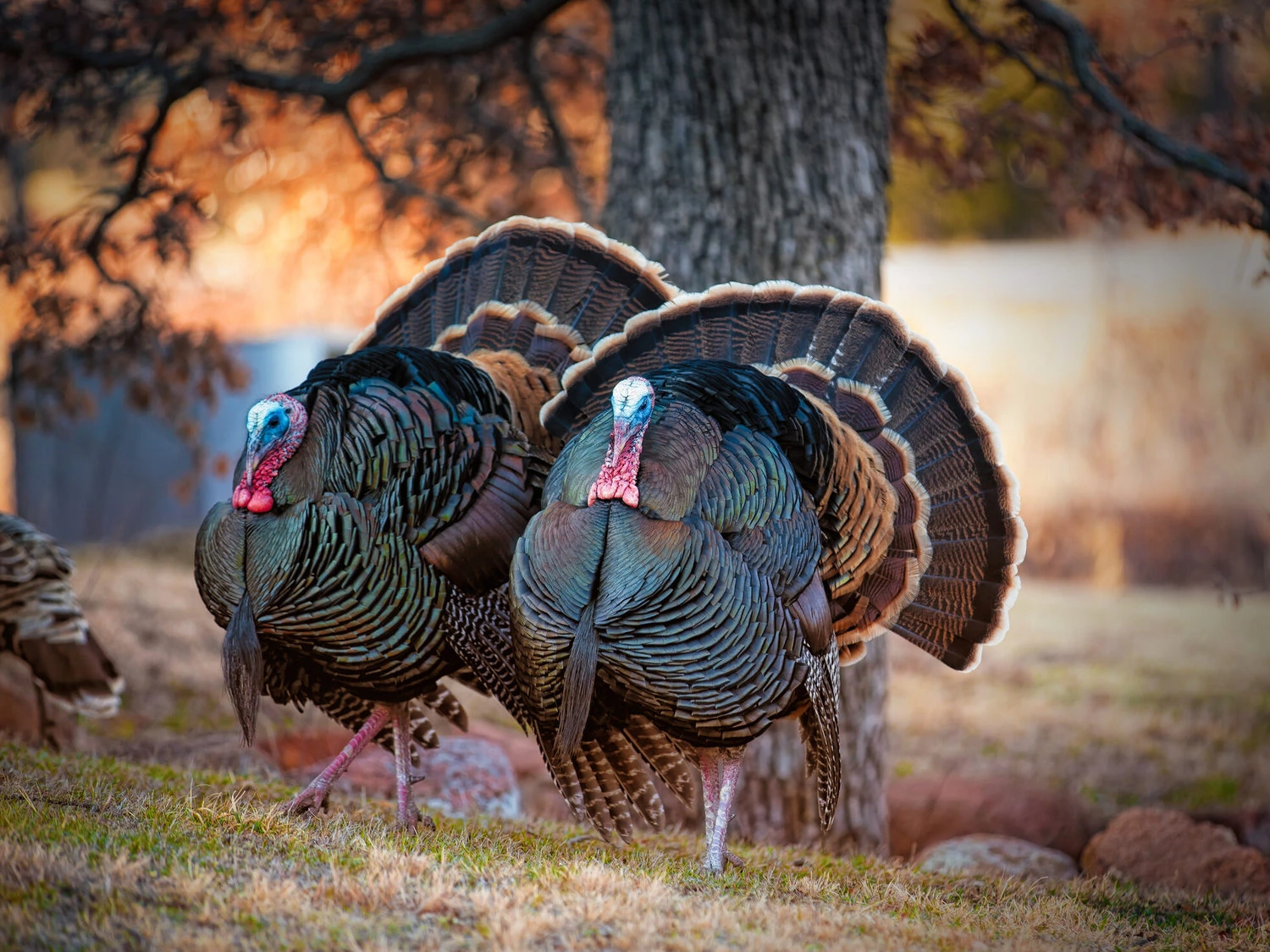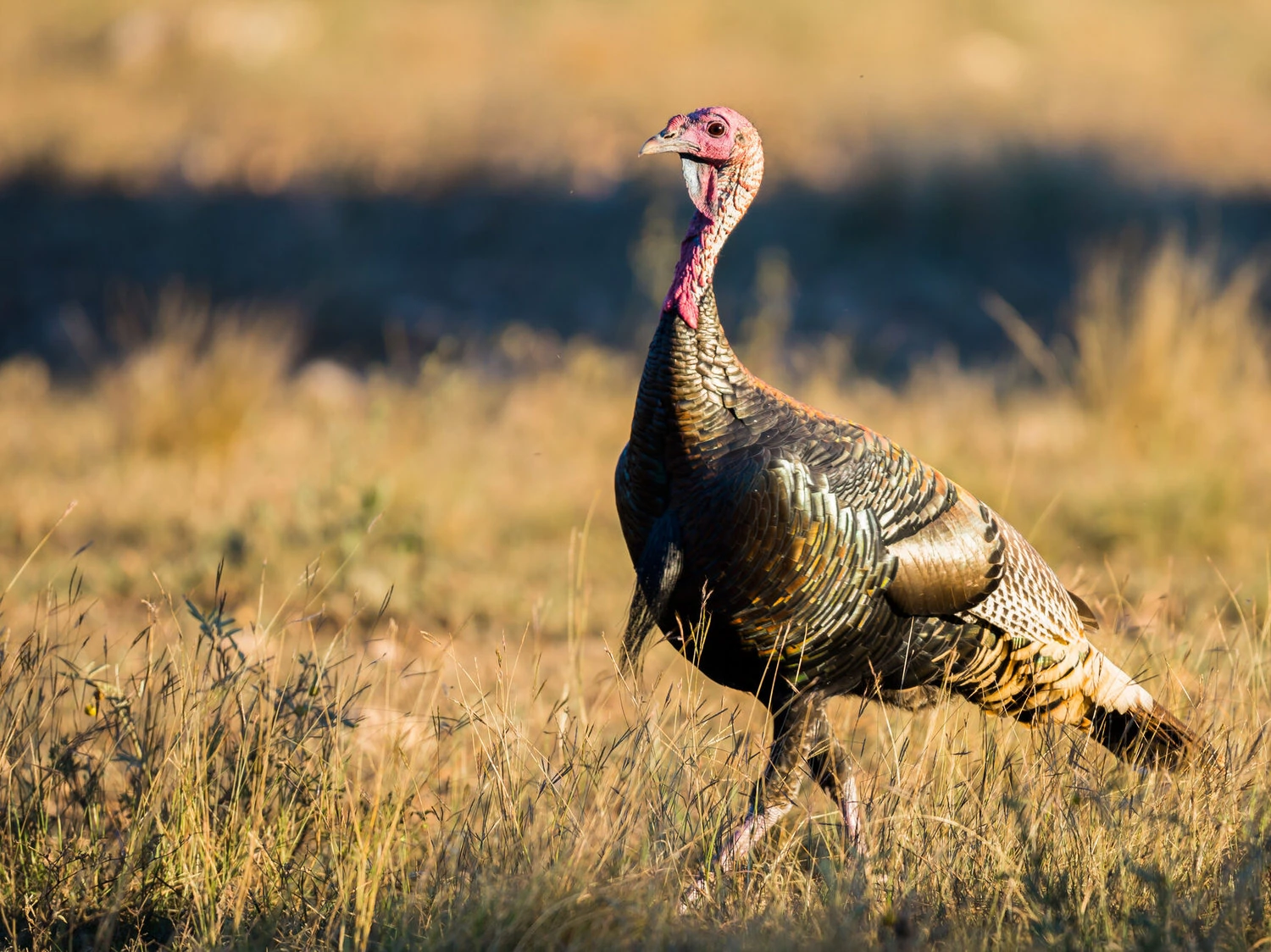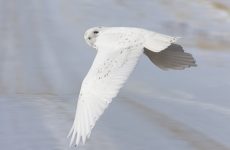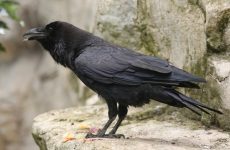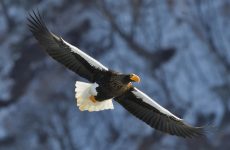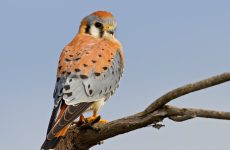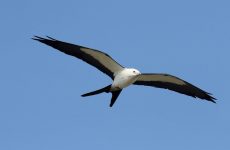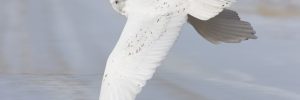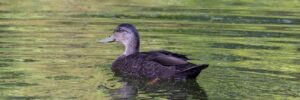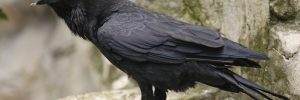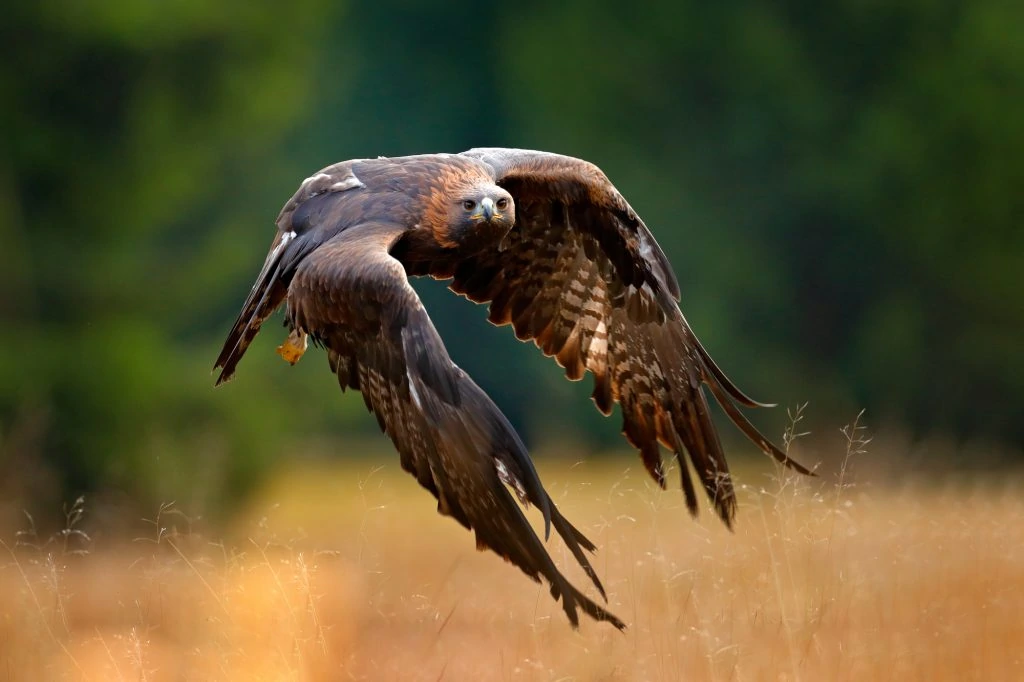
Birds can be surprisingly large, especially if they spread their wings to an immense size and there are some very large birds in New Brunswick.
- The largest bird by weight in New Brunswick is the Wild Turkey at 381 ounces
- The largest bird by length in New Brunswick is the American White Pelican at 63 inches
- The largest bird by wingspan in New Brunswick is the American White Pelican at 110 inches
These are the largest birds in New Brunswick in order by weight but check out the lists at the end to find out those largest by size and wingspan.
With their impressive size they should be fairly easy to spot, but how many can you find?
23 Large Birds In New Brunswick:
1. Wild Turkey
Wild Turkeys are considered rare or accidental species in New Brunswick but there have been some sightings in the west of the province all year.
They have snoods (a fleshy flap on the bill) that expand, elongate, and change color depending on their emotions, like when they’re excited or threatened.
2. American White Pelican
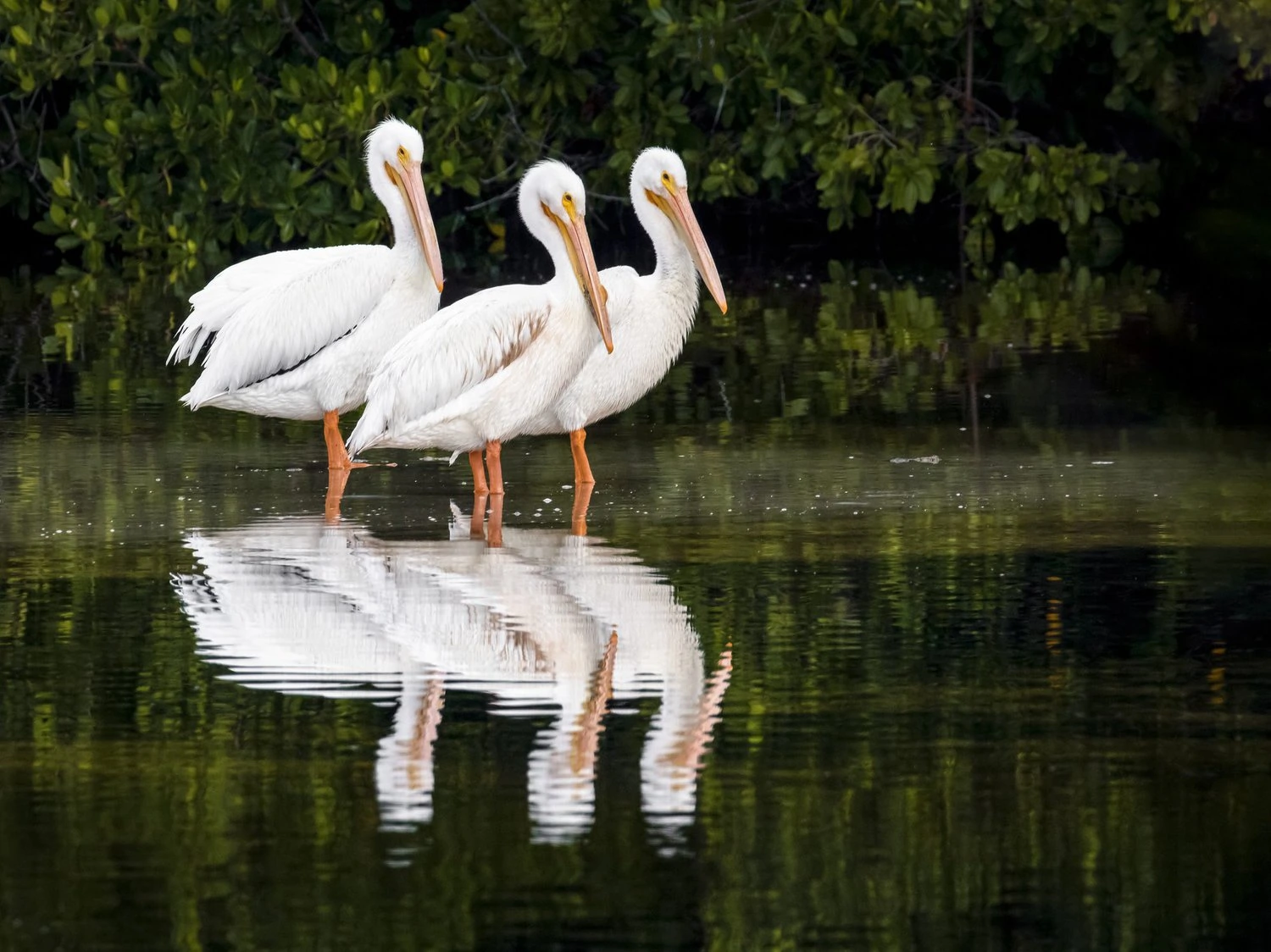
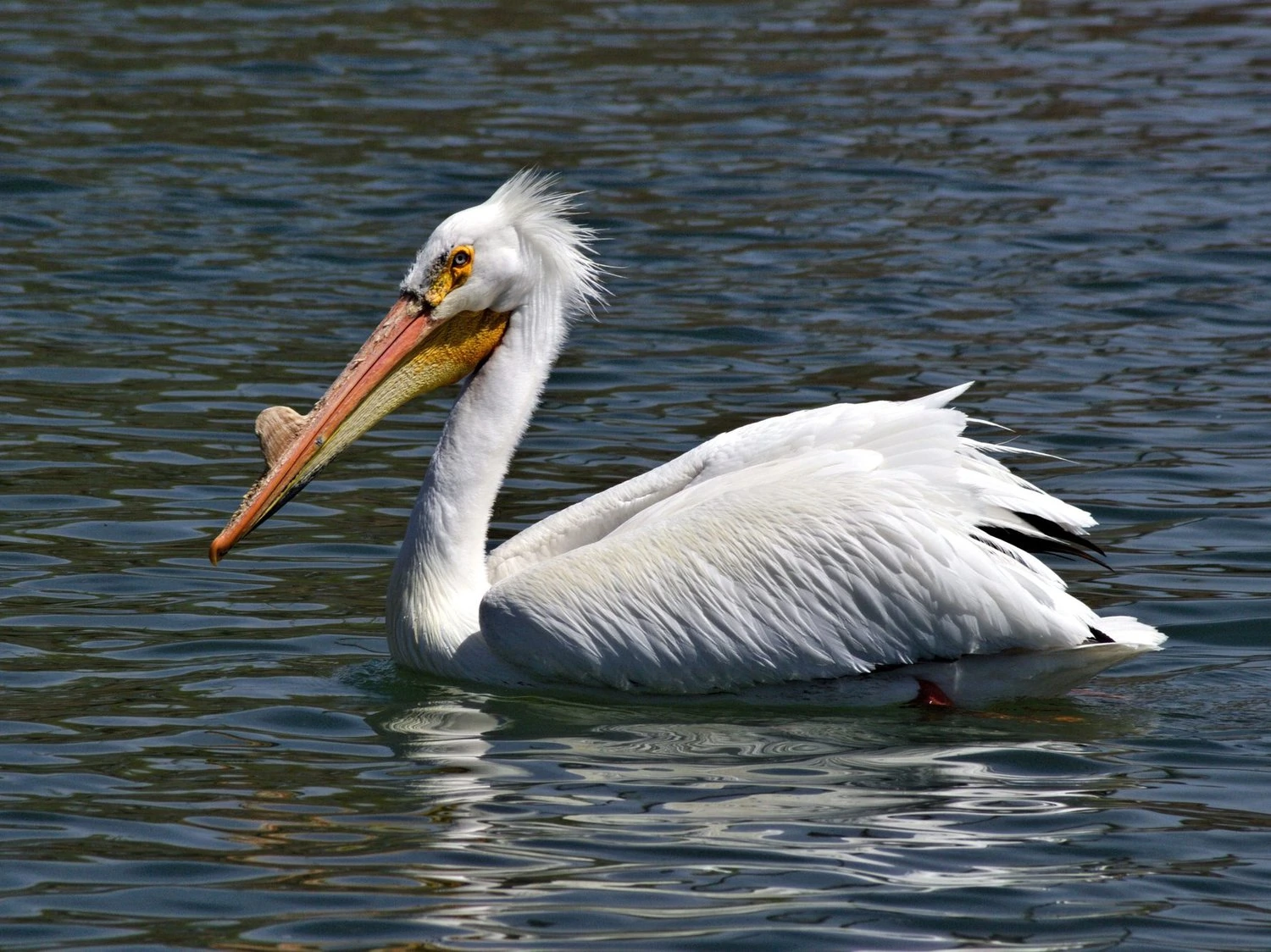
American White Pelicans are rare or accidental species in New Brunswick and there have only been a few sightings in the province. They were last seen around Kingsclear.
American White Pelicans are large soaring birds that have the second-largest average wingspan of any North American bird.
Non-breeding adult American White Pelicans are white all over, except for black flight feathers that are only visible when in flight or when the wings are spread. Breeding adults grow a yellow plate on their upper bills, like a horn.
- Pelecanus erythrorhynchos
- Length: 60 – 63 in (152 – 160 cm)
- Weight: 246.4 oz (6983 g)
- Wingspan: 96 – 110 in (244 – 279 cm)
American White Pelicans breed in remote lakes inland in North America before spending the winter on the southern Pacific Coast of the US, the Gulf of Mexico, Mexico, and Central America. They can be spotted during migration in western and central US states.
You can find American White Pelicans in shallow freshwater lakes, wetlands, and edges of lakes and rivers. In the winter, you can find them in coastal bays, inlets, and estuaries where they forage in shallow water and rest on sandbars.
American White Pelicans mostly eat fish. They swim on the surface and capture their prey through their huge bills.
American White Pelican calls: These birds are usually silent or only make a few grunts. However, the young can be noisy in the large colonies begging for food.
Fun Facts: The long and huge bill of the American White Pelican is capable of holding three gallons of water. When it scoops up fish from the sea, it tilts its bill down to drain the water so it can then swallow the fish that’s left inside its throat sac.
3. Canada Goose
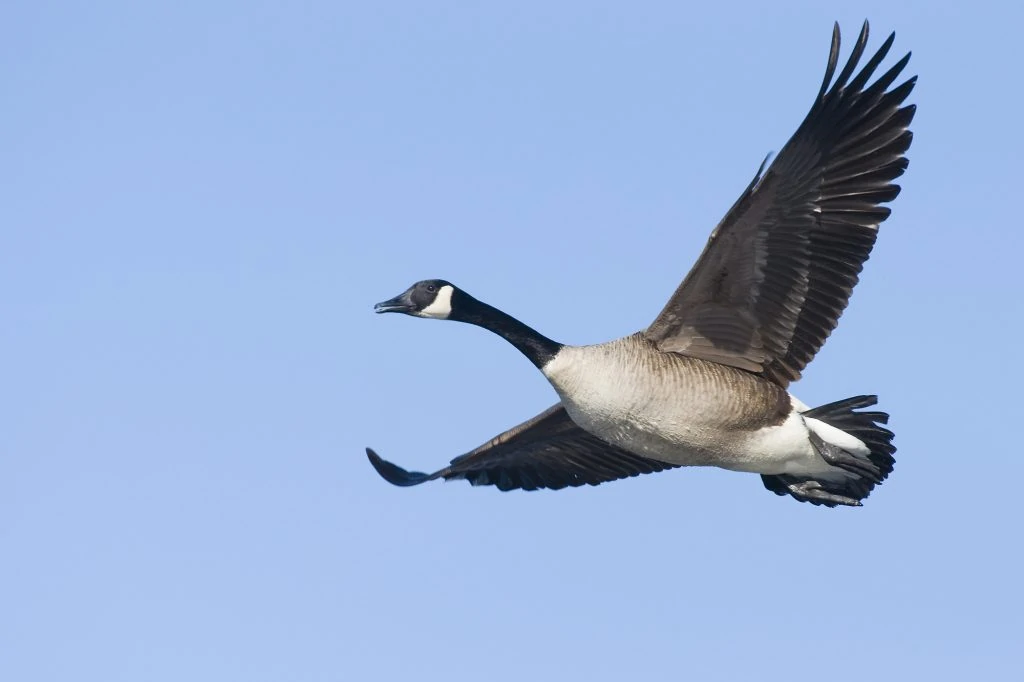
Canada Geese are spotted in New Brunswick from March to November, but some hang around through winter. They are recorded in 19% of summer checklists and 2% of winter checklists submitted by bird watchers for the province.
Canada Geese are large, long-necked geese recognized for their black head and easily identifiable white chin straps, and loud honking calls.
Their bodies are brown with a tan or pale chest and white rump. The color of the bodies among the subspecies may be shades of gray or brown. Their legs and webbed feet are black.
- Branta canadensis
- Length: 25 – 45 in (64 – 114 cm)
- Weight: 230.09 oz (6521 g)
- Wingspan: 70 – 75 in (178 – 190 cm)
As their name would suggest, Canada Geese breed in Canada and migrate for the winter to southern US states, but those in northern US states remain all year and do not migrate. They are also found in western Europe.
You can find Canada Geese practically anywhere. They are often seen near lakes and rivers, basically, anywhere there’s a body of water and an abundant food source.
In some places, their population has risen considerably and they’re considered pests.
Canada Geese mainly eat grasses when they’re on land and small aquatic insects and fish when they’re on the water, but will raid your trash can if they can.
Canada Goose Call:
Fun Fact: During the breeding season, adults lose their flight feathers because it coincides with their molting season. They only regain their feathers after twenty to forty days, just in time for them to fly with their young.
4. Bald Eagle
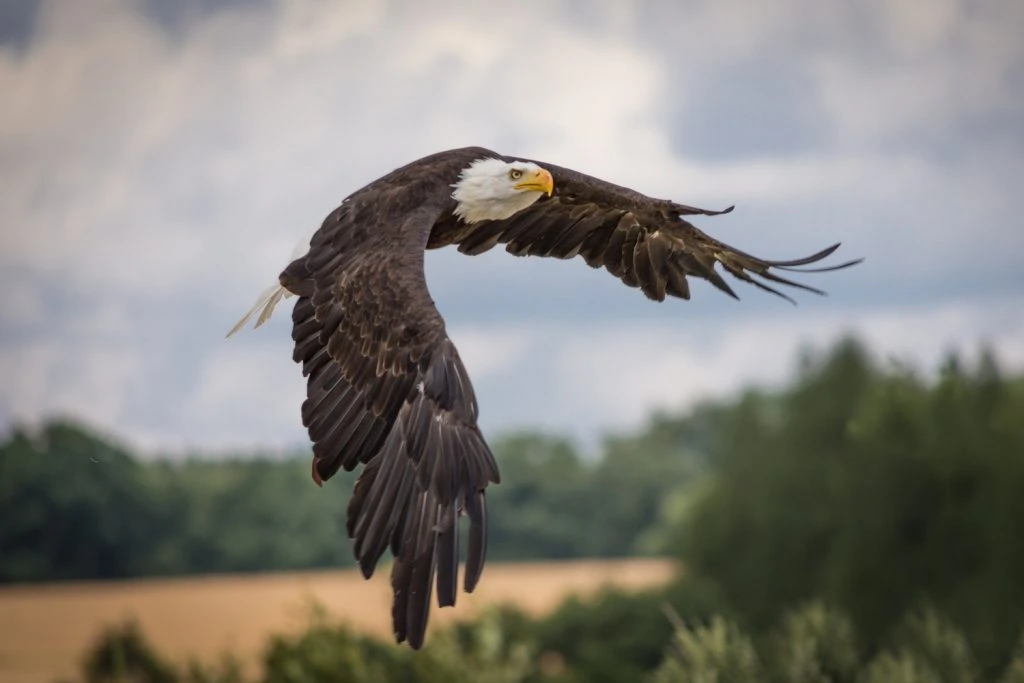
Bald Eagles can be spotted all year in New Brunswick. They appear in 13% of summer and winter checklists.
The Bald Eagle is a widely-recognized bird of prey. It has a white head, yellow eyes, and a large, hooked yellow bill. Its body is chocolate brown, and its legs are yellow, with huge talons.
Females look similar to males, except they’re about 25% larger. Juveniles have dark brown heads and bodies with variable white mottling or streaking until they reach their fifth year.
- Haliaeetus leucocephalus
- Length: 34 – 43 in (86 – 109 cm)
- Weight: 168 oz (4761 g)
- Wingspan: 72 – 96 in (183 – 244 cm)
Bald Eagles breed predominantly in Canada and then migrate to the United States for winter. However, some remain resident all year, especially in coastal regions.
You can find the Bald Eagle, during its breeding season, in wetland environments. Open and large bodies of water with plenty of fish are ideal spots.
Bald Eagles are opportunistic feeders and will eat what is available. Their favorite food is fish, and they prefer large ones, like trout and salmon, but also take birds and mammals. They may hunt these fish themselves or steal them away from other birds.
Bald Eagle Calls: The squeak of the Bald Eagle does not fit its size as they make a rather disappointing high-pitched whistle!
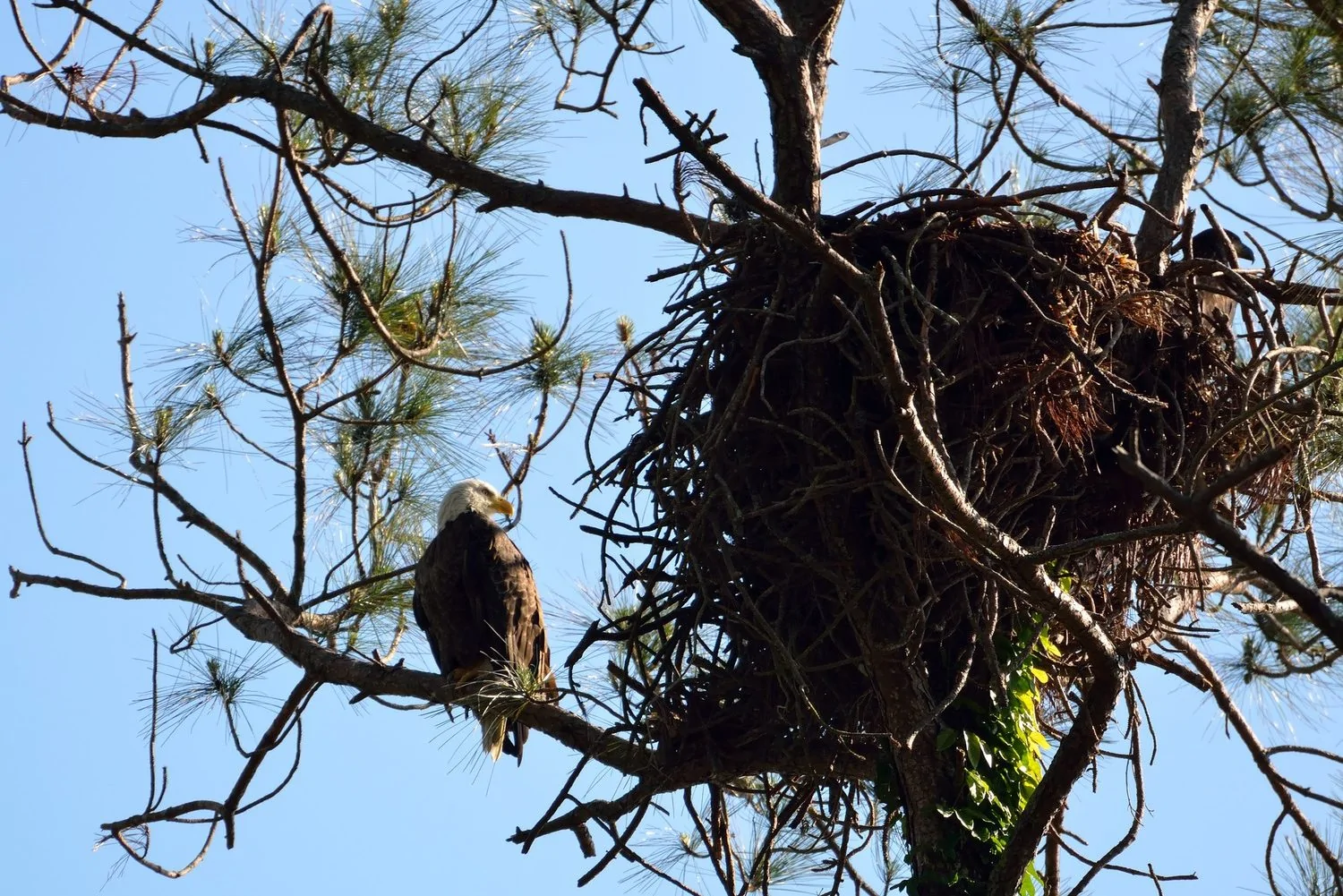
Fun Fact: The Bald Eagle has been the national symbol of America since 1782. It may be named “bald,” but it isn’t actually bald. The old version of “bald” actually meant “white,” referring to its white head and tail.
5. Golden Eagle

Golden Eagles are not often spotted in New Brunswick but there have been a couple of sightings here during winter from September to mid-April, mostly in the south of the province.
Golden Eagles are the most widely distributed eagles in the world. Their crown and nape (neck) are golden-brown and are a sight to behold when in the right light.
Their bodies are darker brown but with pale flight feathers. Their eyes vary from light yellow to dark brown and are ringed in yellow.
While adults look similar, females are larger than males. Juveniles are also similar, but they tend to have a darker color.
- Aquila chrysaetos
- Length: 27 – 38 in (69 – 97 cm)
- Weight: 160 oz (4534 g)
- Wingspan: 72 – 96 in (183 – 244 cm)
Golden Eagles that breed in Canada and Alaska migrate south for winter to the United States and northern Mexico. However, Golden Eagles in western US states remain all year.
You can find Golden Eagles in mountainous habitats far above the treelines. They also inhabit canyons, riverside cliffs, and bluffs when nesting. They generally prefer to avoid human presence.
Since Golden Eagles are birds of prey, naturally, they’d prey on small to medium-sized animals like rabbits, prairie dogs, and hares. On occasion, they may also hunt and take down larger prey like cranes, swans, and domestic livestock.
They usually hunt in pairs, with one chasing down the prey until it gets tired, and then the other swoops in for the kill.
Golden Eagle Call: The main calls that are made by Golden Eagles are during the breeding season when chicks are begging, and parents respond. Otherwise, they are pretty quiet. They make high-pitched whistled calls.
Fun Fact: The Golden Eagle, the Rough-legged Hawk, and the Ferruginous Hawk are the only American birds of prey that have feathers on their legs up to their toes.
6. Sandhill Crane
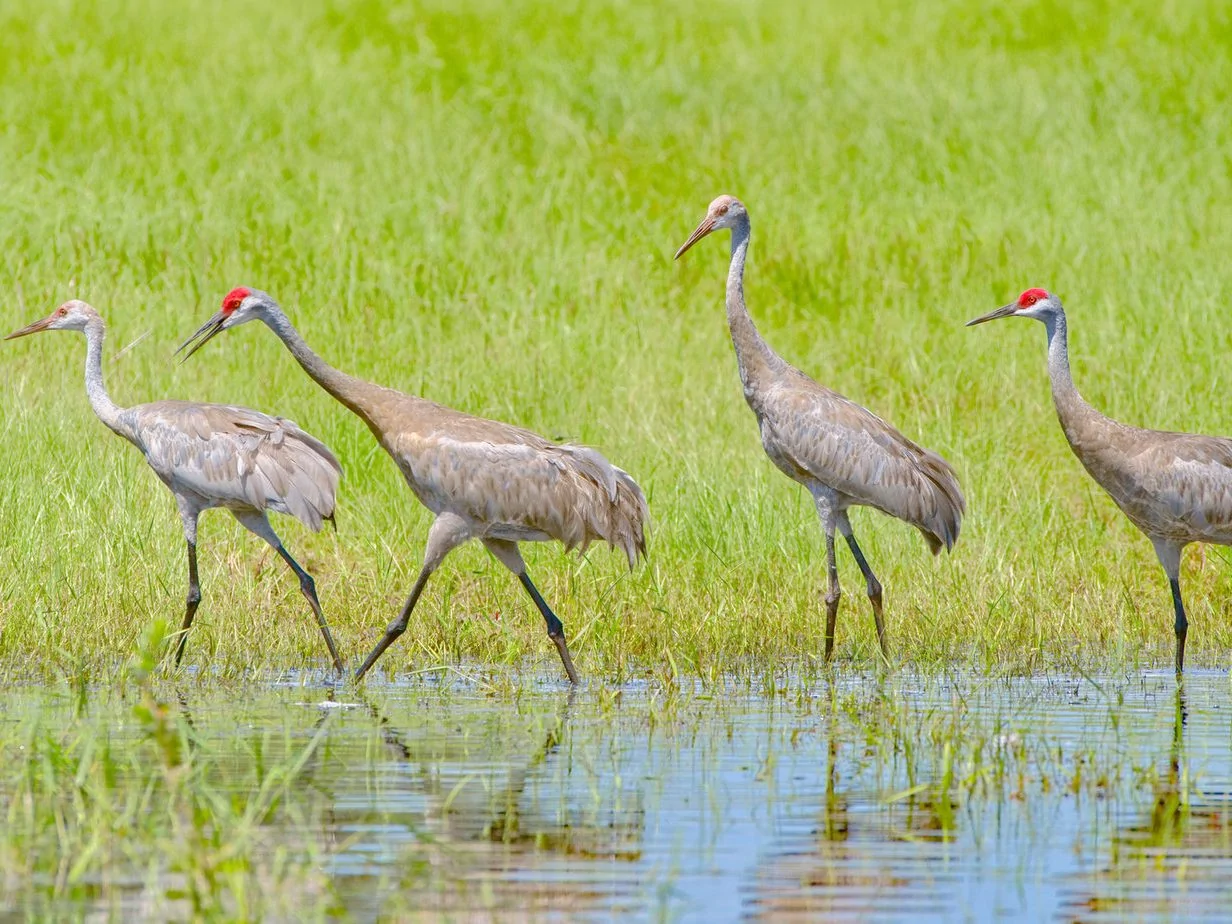
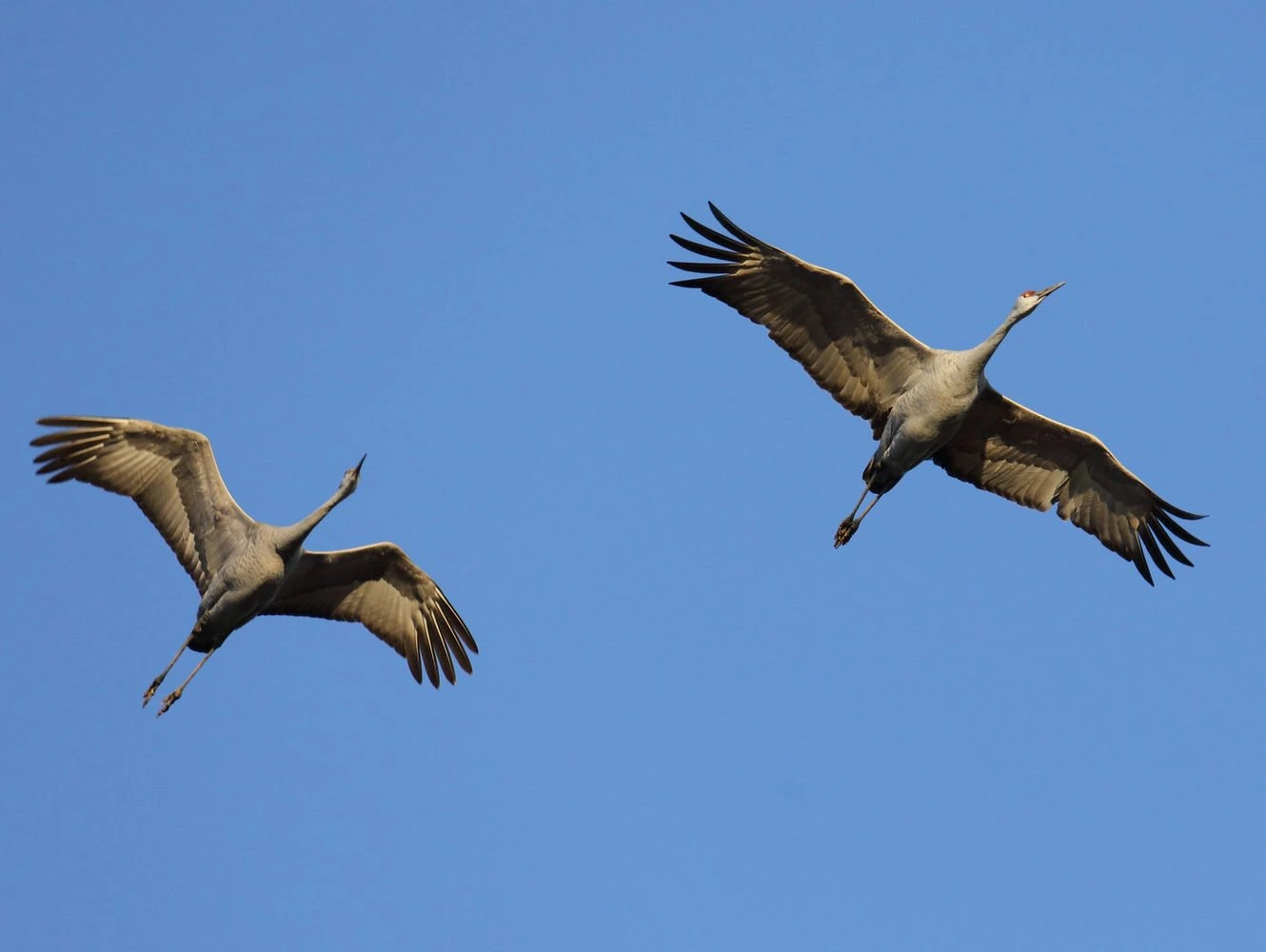
Sandhill Cranes are extremely rare in New Brunswick and are considered accidental species. However, some have been spotted in the east of the province during migration
Adult Sandhill Cranes are tall, gray heavy-bodied birds with very distinctive bright-red crowns and white cheeks and necks. They have long black bills and long, black legs. They have heavy-looking, droopy feathers at the back.
Breeding adults may have more rusty or tan coloring on their gray bodies. Juveniles, on the other hand, are rusty brown without any white cheeks or red crowns.
- Antigone canadensis
- Length: 34 – 48 in (86 – 122 cm)
- Weight: 132.27 oz (3749 g)
- Wingspan: 73 – 90 in (185 – 229 cm)
Sandhill Cranes breed in Alaska, Canada, and northern and central US states before migrating to southern US states for winter.
You can find Sandhill Cranes during winter in shallow lakes, irrigated croplands, pastures, and grasslands. From spring to summer, they move to and stay in their breeding grounds in open wetland habitats with shrubs or trees.
Sandhill Cranes are omnivores and feed on both land and water. When on land, they eat seeds, grains, berries, and tubers. When on water, they will pluck out plants from the water, or probe through mud and vegetation for amphibians, reptiles, and small mammals with their long bills.
Sandhill Crane Calls:
Fun Facts: Sandhill Cranes find their mates by performing unison calling (loudest and most noticeable calls) and through dancing rituals. They are monogamous and mate for life.
7. Great Cormorant
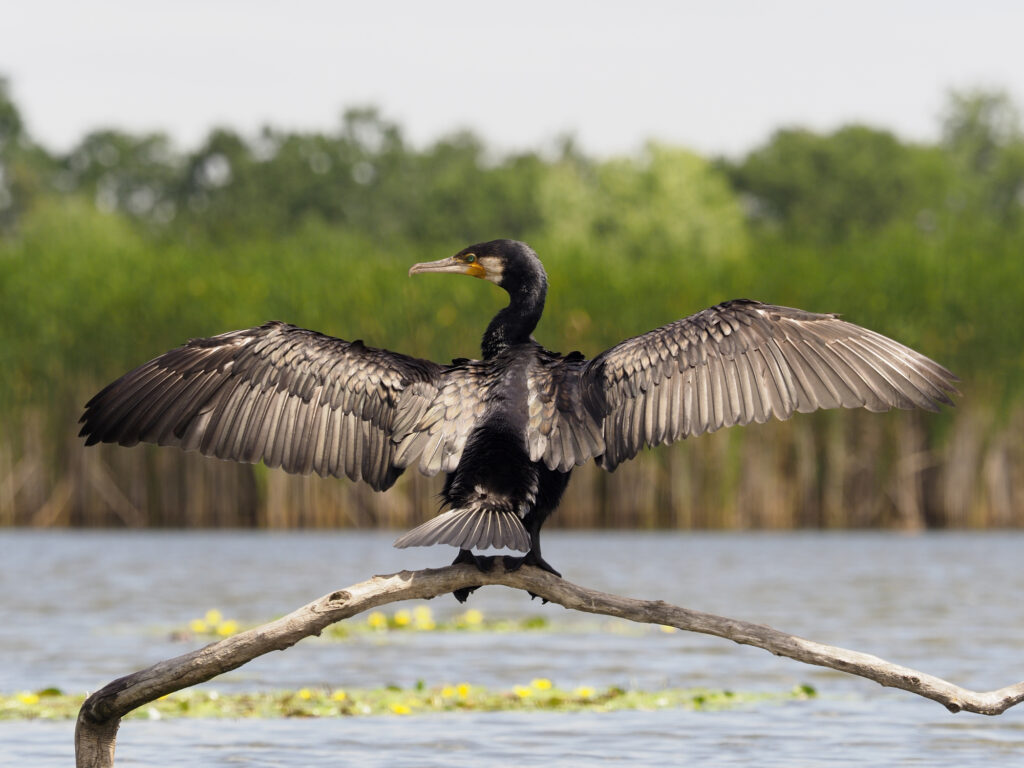
Great Cormorants are spotted along the coast of New Brunswick all year but their numbers increase during winter.
The Great Cormorant is a stocky bird with a blocky head, thick neck, and hooked bill. Adults are almost black everywhere except for their white throats and yellow skin around the bill. When breeding, adults have a white patch on their thighs and white neck feathers.
Juveniles are mostly brown with white chests.
- Phalacrocorax carbo
- Length: 33.1-35.4 in (84-90 cm)
- Weight: 91.7-130.5 oz (2600-3700 g)
- Wingspan: 51.2-63.0 in (130-160 cm)
You can find the Great Cormorant near rocky coastlines, sheltered bays, and areas with access to its feeding ground like estuaries, lakes, and rivers.
As a waterbird, its main food is fish which the Great Cormorant catches by diving and capturing it with its beak.
Great Cormorant call:
FUN FACT: The Great Cormorant can dive up to a depth of almost 6 meters and it’s possible that their hearing has evolved to enable them to better catch fish at this depth.
8. Great Blue Heron
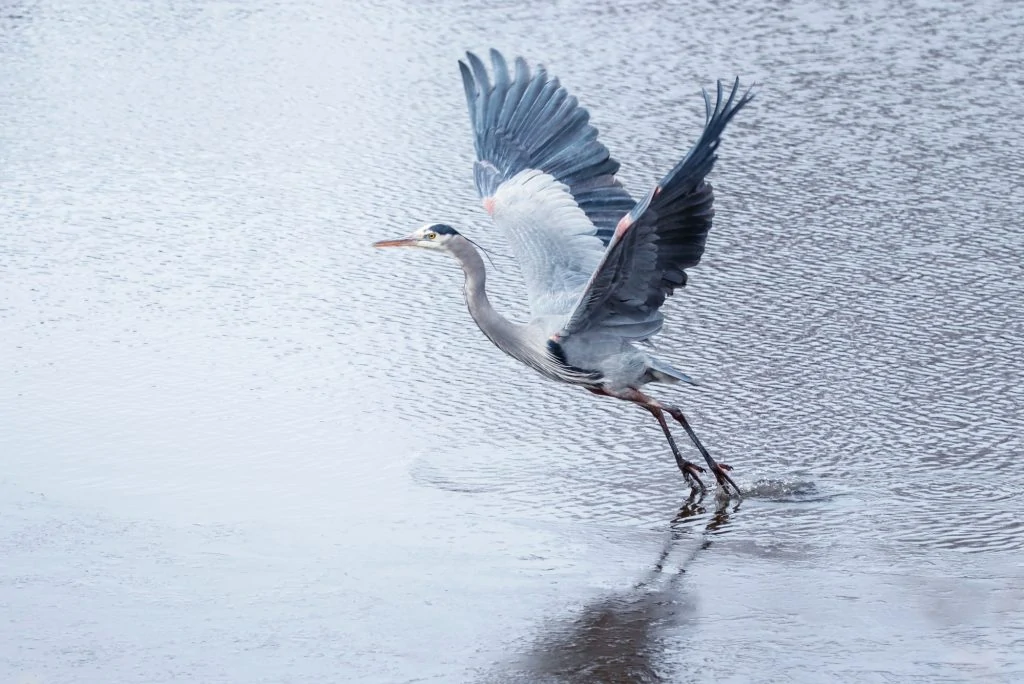
Great Blue Herons are mainly spotted along the coast of New Brunswick during the breeding season but their numbers increase during fall migration from August to October.
They occur in 11% of summer checklists and 24% of checklists during migration.
Great Blue Herons are very large, majestic birds that are the largest heron native to North America. Their pale gray bodies can look white in flight.
They have a white face with a black crest or plume that extends from the front of their eyes to the back of their heads. Their bills are yellow-orangish and they have long gray necks with black and white streaking in the front, pale grayish-blue bodies with dark wingtips, and long gray legs.
- Ardea herodias
- Length: 46 – 52 in (117 – 132 cm)
- Weight: 128 oz (3628 g)
- Wingspan: 77 – 82 in (196 – 208 cm)
Great Blue Herons remain in most US states all year, but those that breed in the Mid-West and Canada migrate south.
You can find Great Blue Herons in many wetland environments. They can be present in fresh and saltwater marshes, mangrove swamps, flooded marshes, lake edges, or shorelines.
Great Blue Heron Call:
Fun Fact: Great Blue Herons defend their feeding territory with dramatic wing outstretched displays, with their heads thrown back.
9. Snowy Owl
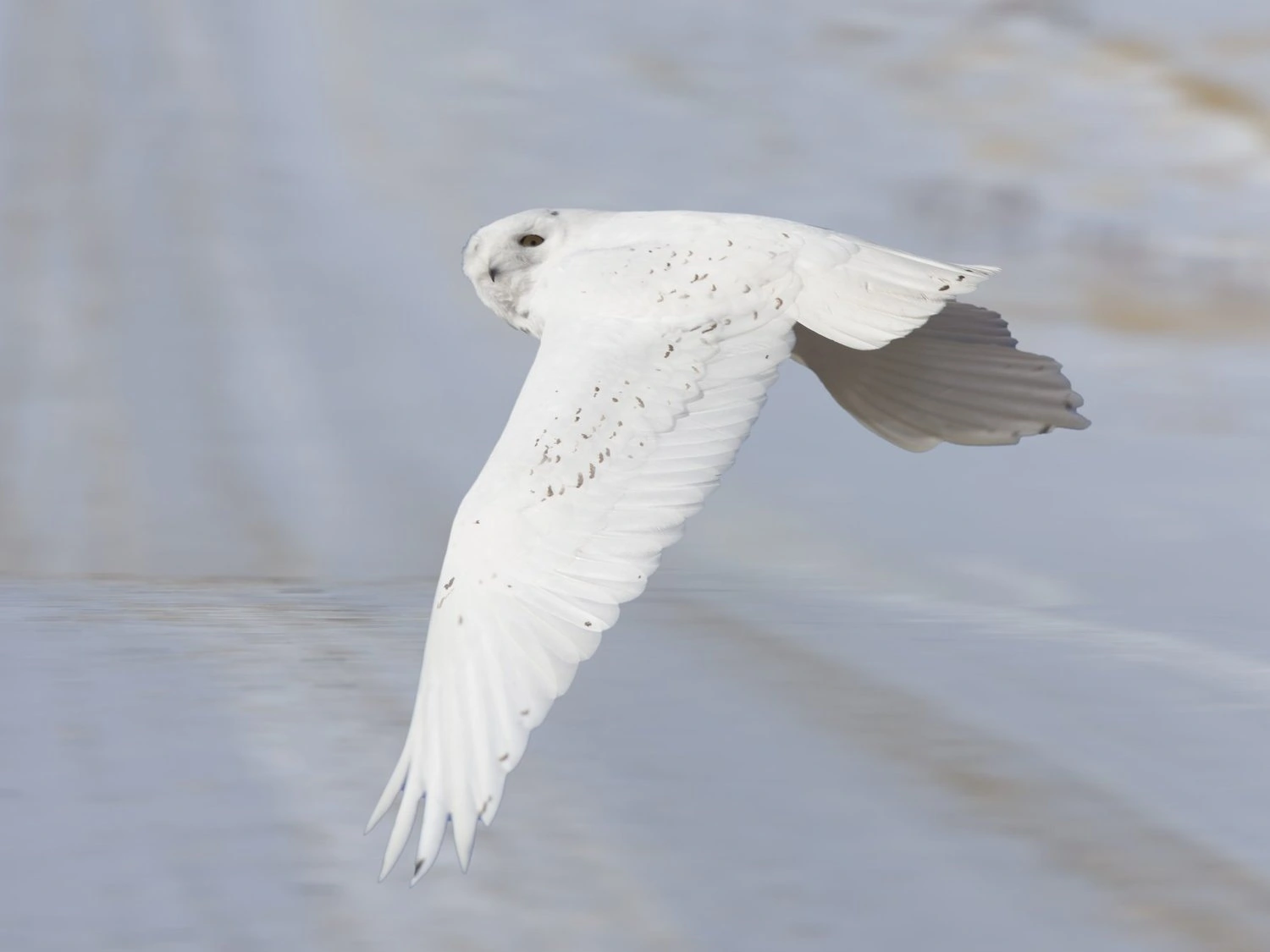
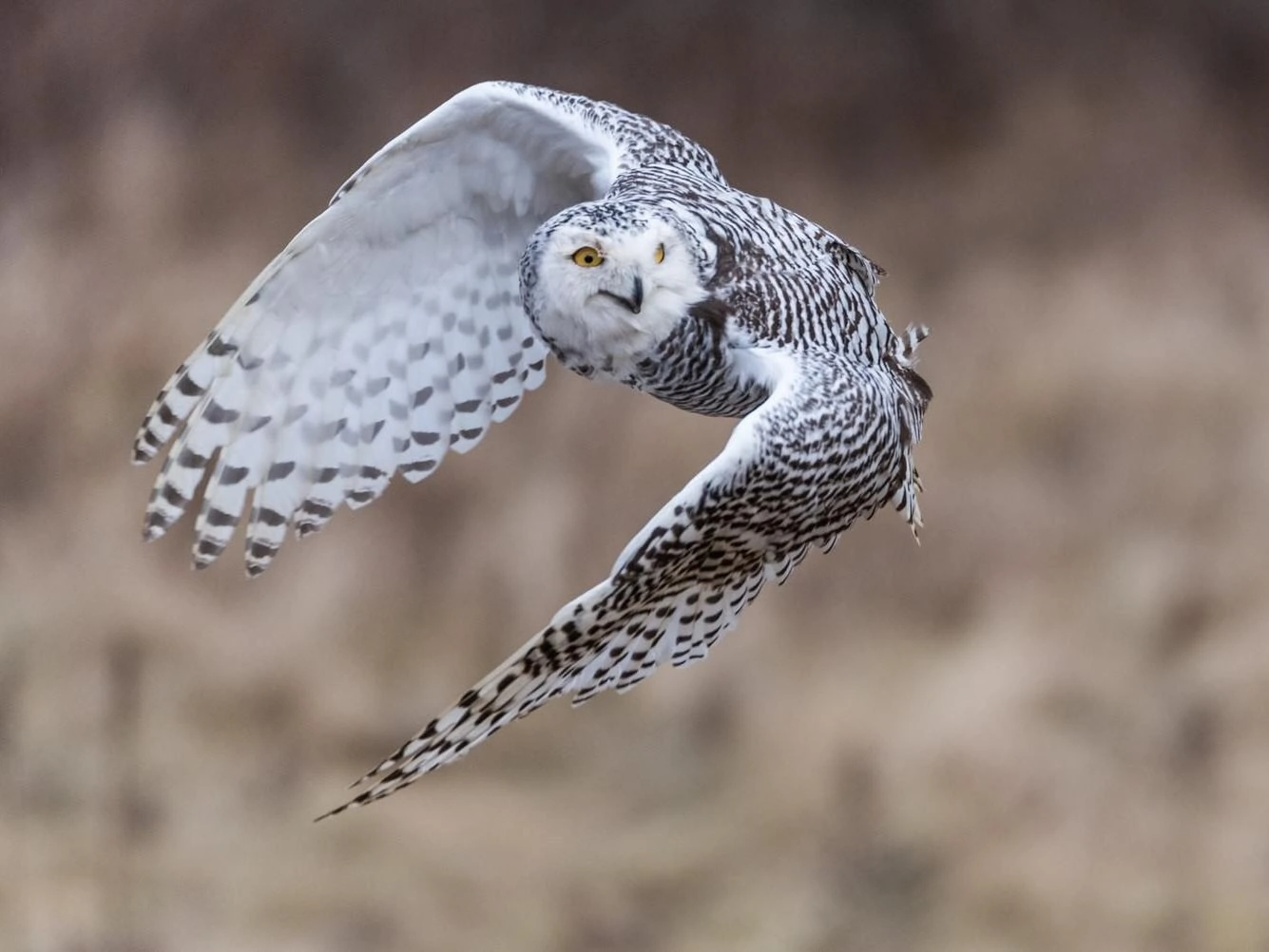
Snowy Owls are vulnerable species in New Brunswick but they spend winter here from mid-October to March, and a few are also spotted until June.
Male Snowy Owls are either white all over or have a small amount of brown spots.
Female Snowy Owls have flecks of dark brown to black on their backs, wings, and flanks, unlike the more white males. They also have thicker and more complete barring on their tails compared to the males.
Juveniles have extensive brown barring all over their bodies except their faces, underwings, legs, and feet.
- Bubo scandiacus
- Length: 20.5-27.9 in (52-71 cm)
- Weight: 56.4-104.1 oz (1600-2950 g)
- Wingspan: 49.6-57.1 in (126-145 cm)
Snowy Owls breed in the arctic around the world, including the north of Canada, and migrate to southern Canada and northern US states.
You can find Snowy Owls in open Arctic tundra and prefer to situate themselves in areas with vantage points like hummocks, ridges, knolls, and bluffs so that they can keep a close watch on their surroundings. However, they may move southward for the winter when prey is lacking.
Snowy Owls are diurnal, unlike most other owls, and spend the 24-hour summer daylight hunting in the arctic.
They hunt small mammals, especially lemmings, and can eat 1600 in a year.
They also catch birds in flight, such as ptarmigan or waterfowl. In winter, they will eat rodents, rabbits, squirrels, and birds such as ducks and geese.
Snowy Owls calls: They make a strong raspy Hoo sound. They also hoot, whistle, and hiss if threatened.
Fun Fact: The Snowy Owl is also known as the Arctic Owl, the Polar Owl, and the White Owl.
10. Great Horned Owl
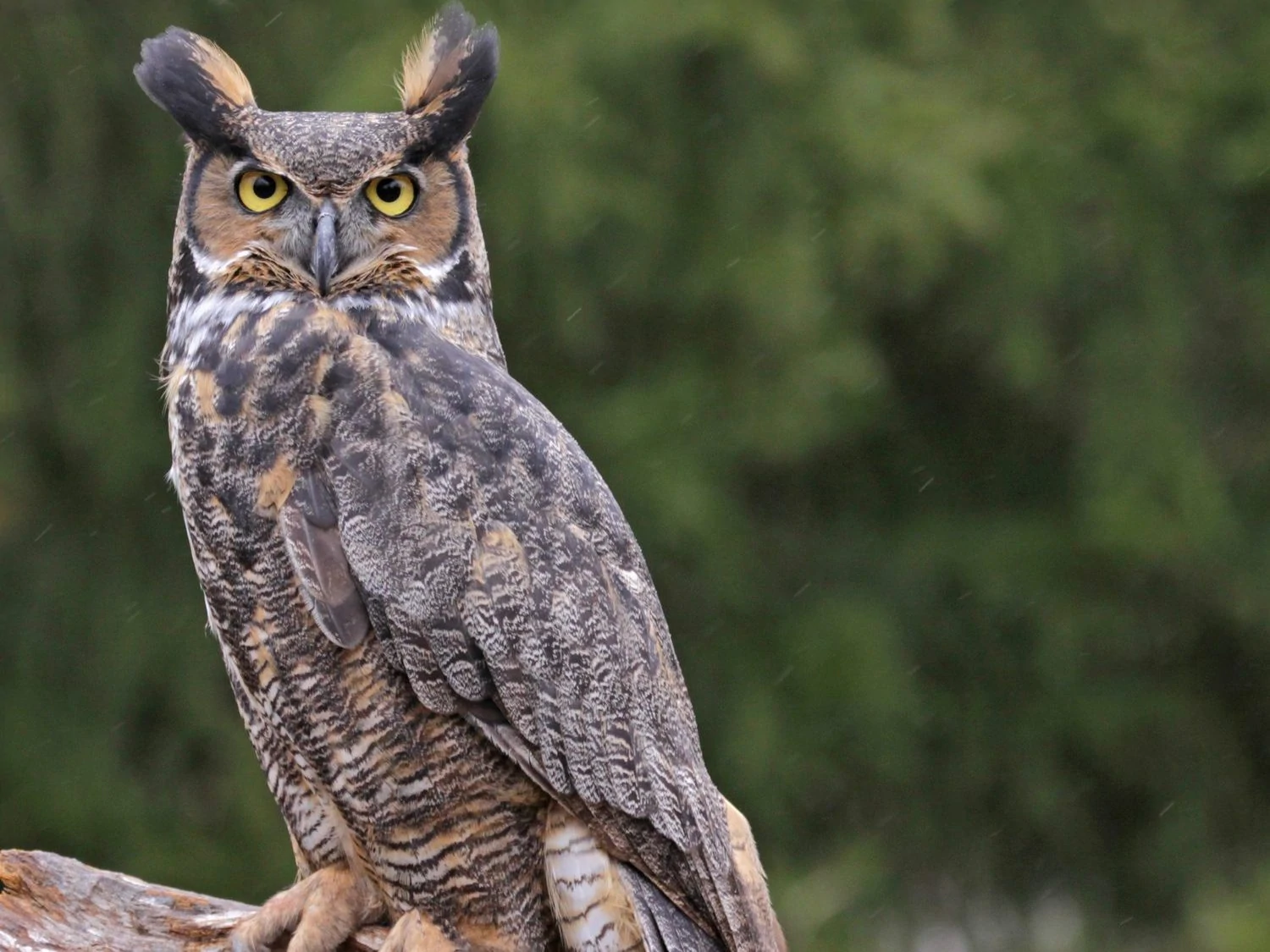
Great Horned Owls are not very common in New Brunswick but they can be spotted in the province all year and are the most frequently spotted owl here.
Great Horned Owls are one of the most common owls in North America.
Their most unique physical characteristic is their “Great Horns” which aren’t really horns but ear tufts. They’re tufts of feathers that they use as camouflage to make them appear like branches of trees.
The coloring and patterns of Great Horned Owls are also mainly for camouflage. Their backs and wings are mottled with gray, brown, black, or white.
- Bubo virginianus
- Length: 18.1 – 24.8 in (46 – 63 cm)
- Weight: 32.1 – 88.2 oz (910 – 2500 g)
- Wingspan: 39.8 – 57.1 in (101 – 145 cm)
Great Horned Owls are widespread throughout North America and do not migrate.
You can find Great Horned Owls in almost any environment in North America. As long as they have nesting sites, roosting sites, and an abundance of prey, they will be able to adapt to forests, deserts, grasslands, or cities.
Their varied diet includes small rodents such as mice, skunks, geese, and hares. They will also eat insects, fish, and carrion. They hunt from a perch, scanning their territory and swooping down to capture their prey with their strong talons.
Great Horned also hunt other raptors such as Ospreys, Peregrine falcons, or other owls.
Great Horned Owls: The distinctive 5-note Hoo call of the Great Horned Owl is made by both males and females, but females are higher pitched. They also make various whistles, shrieks, hisses, and coos.
Fun Fact: Great Horned Owls are the crows’ number one enemy. Crows will usually mob Great Horned Owls in their nests, and that is one of the best ways to find them.
11. Great Black-backed Gull
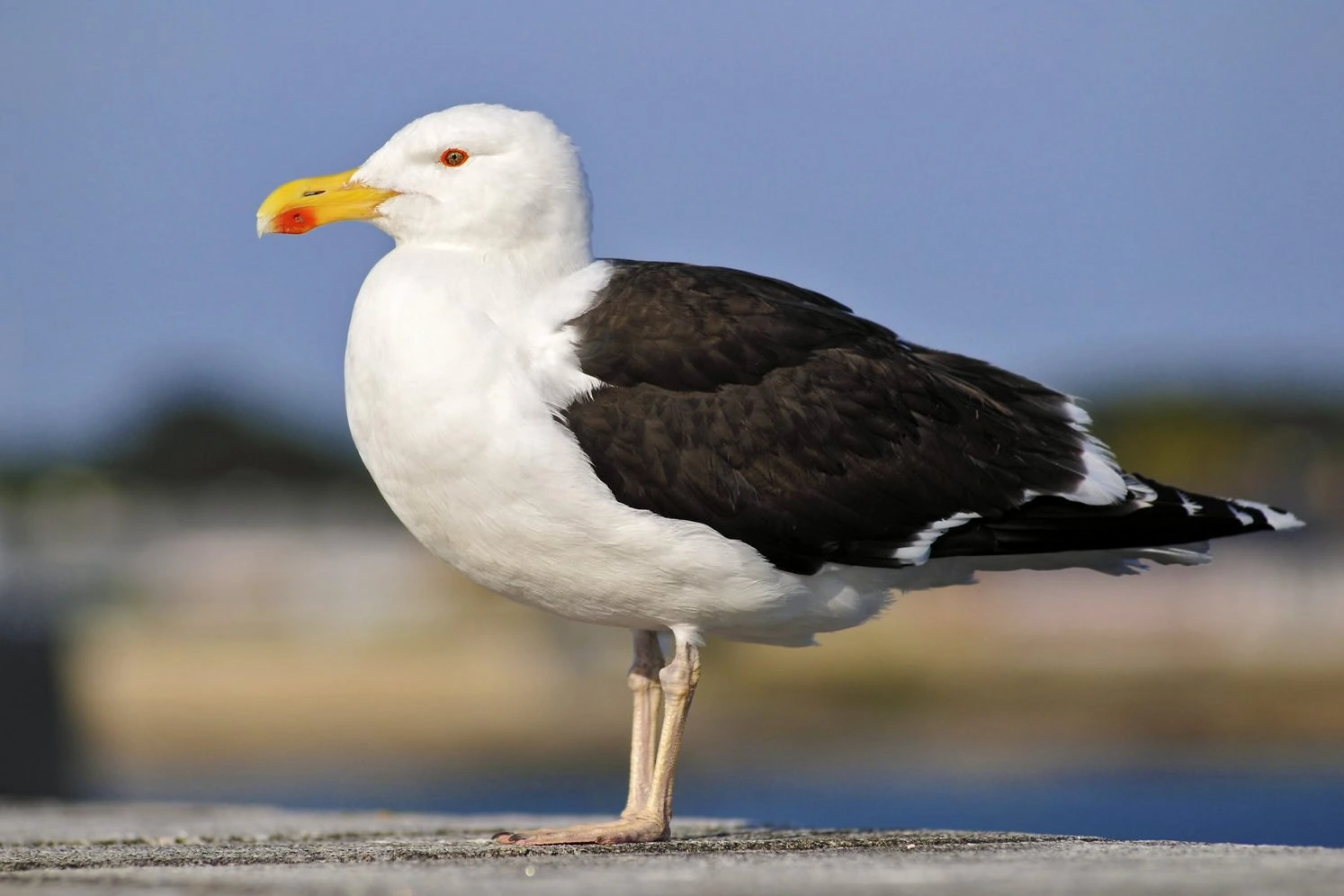
Great Black-backed Gulls are very common in New Brunswick and are spotted mainly along the coast of the province all year. They are recorded in up to 20% of summer and winter checklists.
Great Black-backed Gulls are recognized as the world’s largest gulls. They also have the distinction of being the only large gulls with black coloration on their wings and backs in the North Atlantic.
These gulls have white heads and underparts, yellow eyes rimmed with red, large, yellow bills with a red spot, and pink legs.
Juveniles take four years to reach their mature form and start streaked with gray-brown.
- Larus marinus
- Length: 25 – 31 in (64 – 79 cm)
- Weight: 64 oz (1814 g)
- Wingspan: 60 – 65 in (152 – 165 cm)
You can find Great Black-backed Gulls in many coastal environments like rocky and sandy beaches and estuaries. They also move further inland where there are large bodies of water like lakes, ponds, and rivers.
The primary food of Great Black-backed Gulls is fish but they are opportunistic feeders and will eat anything they can swallow from crabs to eggs and even other birds.
Great Black-backed Gull Calls:
Fun Fact: Great Black-backed Gulls are known for having long lives, with the oldest being over 26 years.
12. Osprey
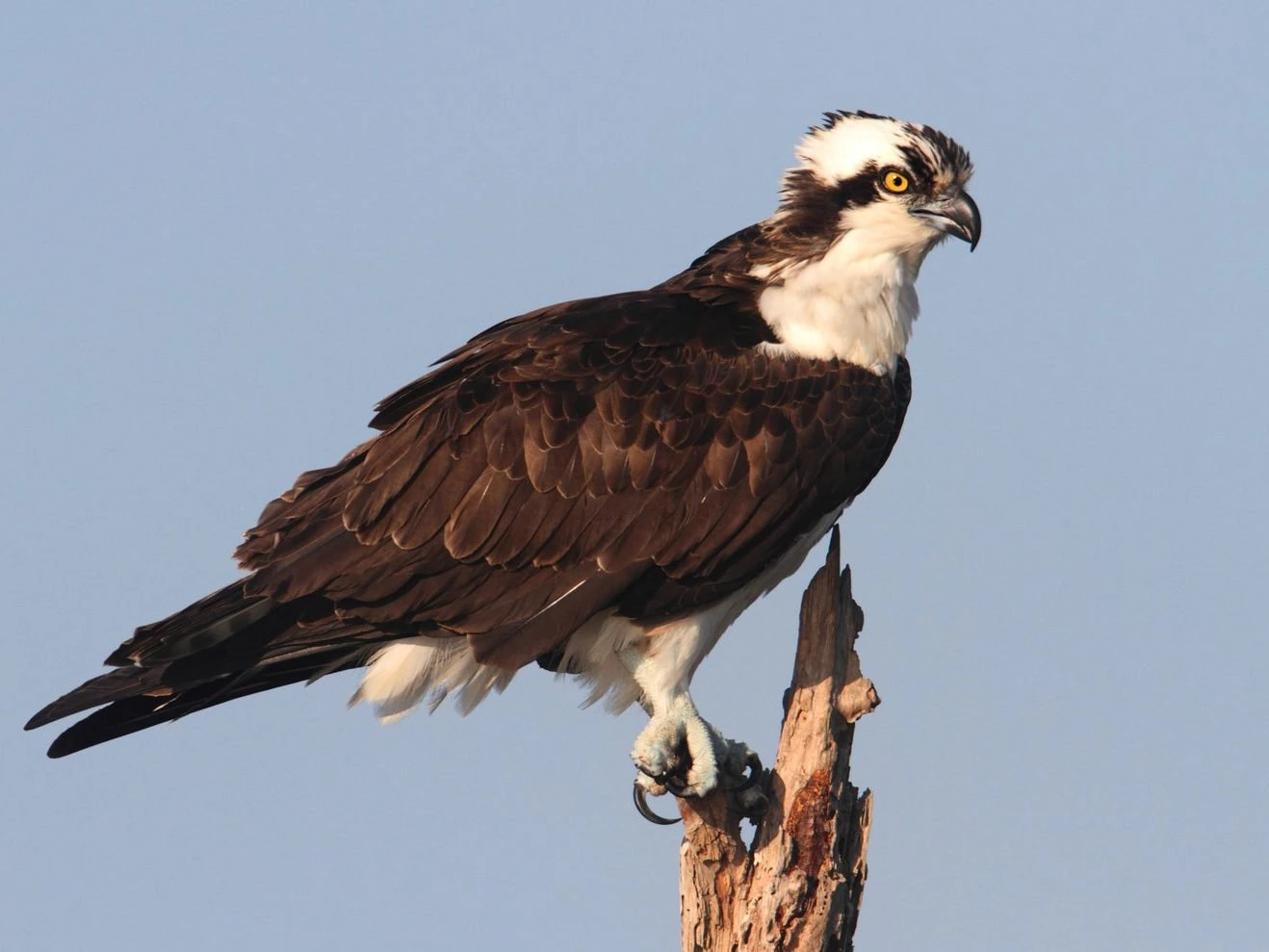
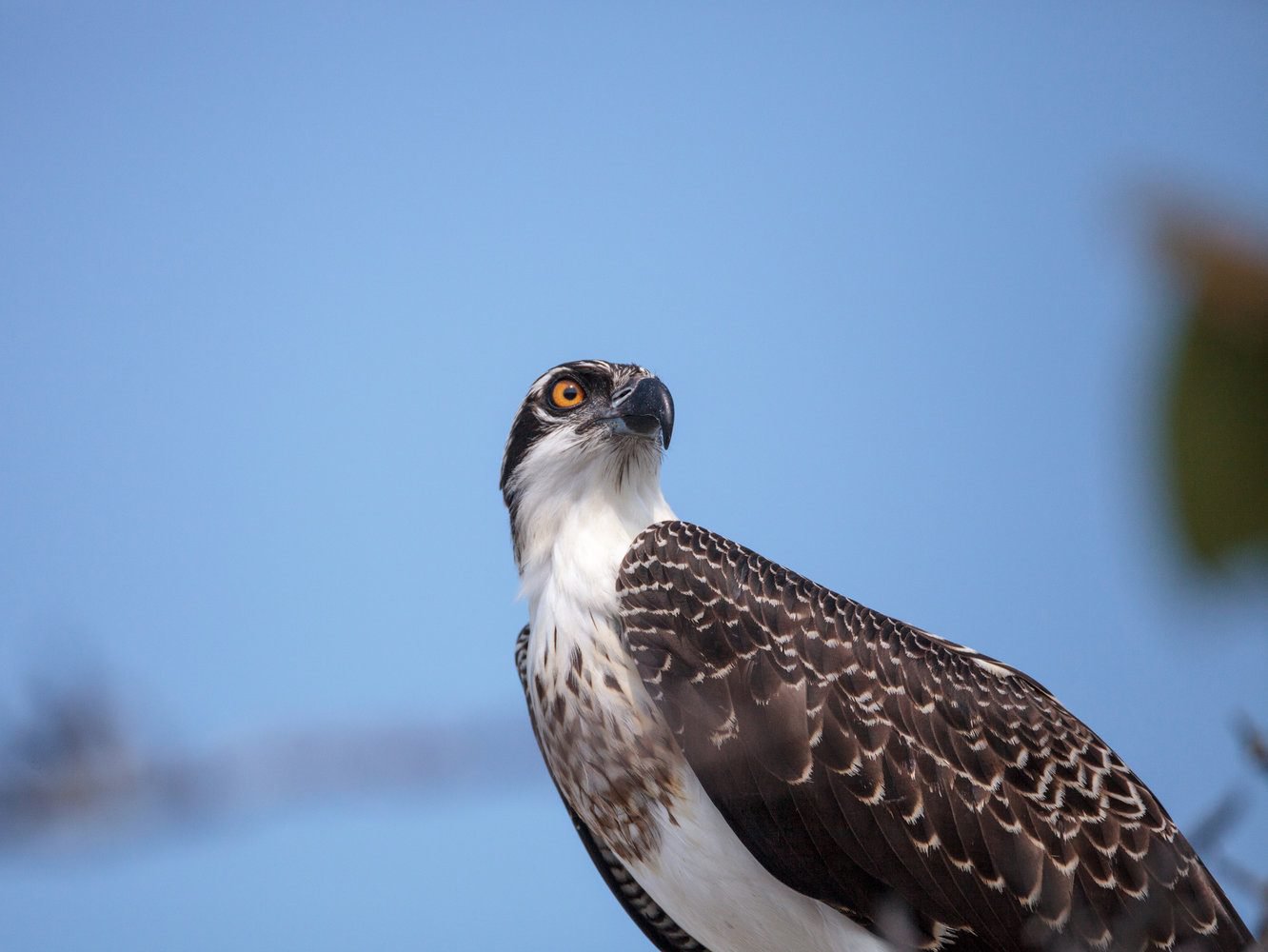
Ospreys spend the breeding season in New Brunswick and are spotted from April to mid-November. They occur in 9% of summer checklists.
Ospreys are large, fierce-looking birds of prey that are also known as fish hawks or sea hawks for their specialized ability to catch large fish.
Their outer toe can turn backward and they have long powerful talons and spiny scales on the soles of their feet which aid them in grasping slippery, strong fish.
They are generally brown on the back and white underneath. Their heads are white, with some brown streaking on their crowns and foreheads. They have a distinctive broad brown line through their eyes that extends to the sides of their necks.
- Pandion haliaetus
- Length: 21 – 24 in (53 – 61 cm)
- Weight: 63.49 oz (1799 g)
- Wingspan: 54 – 72 in (137 -183 cm)
You can find Ospreys practically anywhere in the world, except Antarctica, particularly with large bodies of water. They can tolerate any habitat as long as the food is accessible and abundant.
Ospreys feed almost exclusively on live fish. They will search for prey and when found, hover over water, then dive, feet and talons first, to capture fish.
Osprey Calls:
Fun Facts: Ospreys have reversible outer toes, like owls, that allow them to easily and securely grasp fish. They also have closeable nostrils to keep water from entering their noses when they plunge into the water.
13. Great Egret
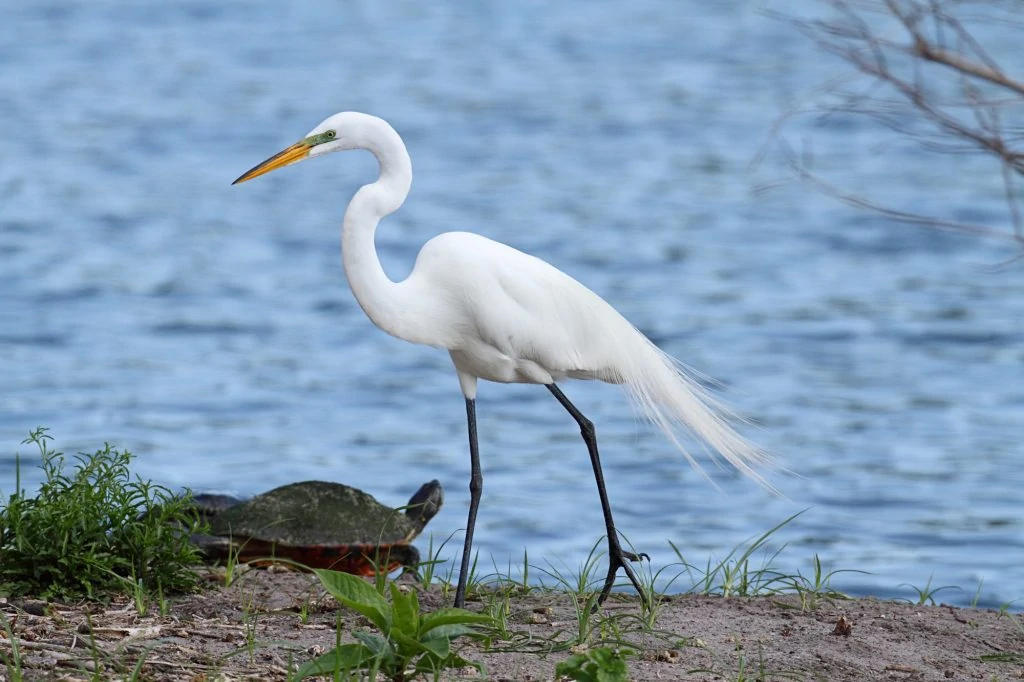
Great Egrets are not very common in New Brunswick but they are spotted here during fall migration in August and September and appear in 1% of checklists at this time.
Great Egrets are at their best during the breeding season when males have neon green facial skin and long, wispy feathers (aigrettes) extending from their backs to their tails, which they show off during courtship, like how a peacock flares out its tail.
They are large, all-white herons, which is why they’re often called Great White Herons. They are also called common egrets. These large birds are white, with dagger-like, long, bright yellow bills and long, black legs and feet.
Non-breeding males, females, and juveniles look alike.
- Ardea alba
- Length: 37 – 41 in (94 – 104cm)
- Weight: 59.96 oz (1699 g)
- Wingspan: 54 – 55 in (137 – 140 cm)
Great Egrets have a vast range around the world. Those in the southern and coastal US states remain all year, but those more inland and in Canada migrate south.
You can find Great Egrets in freshwater and saltwater marshes and tidal flats, but also fish ponds.
Great Egret Calls:
Fun Fact: The Great Egret was almost hunted to extinction because of their long white feathers (aigrettes) that were mainly used to decorate ladies’ hats.
14. Turkey Vulture
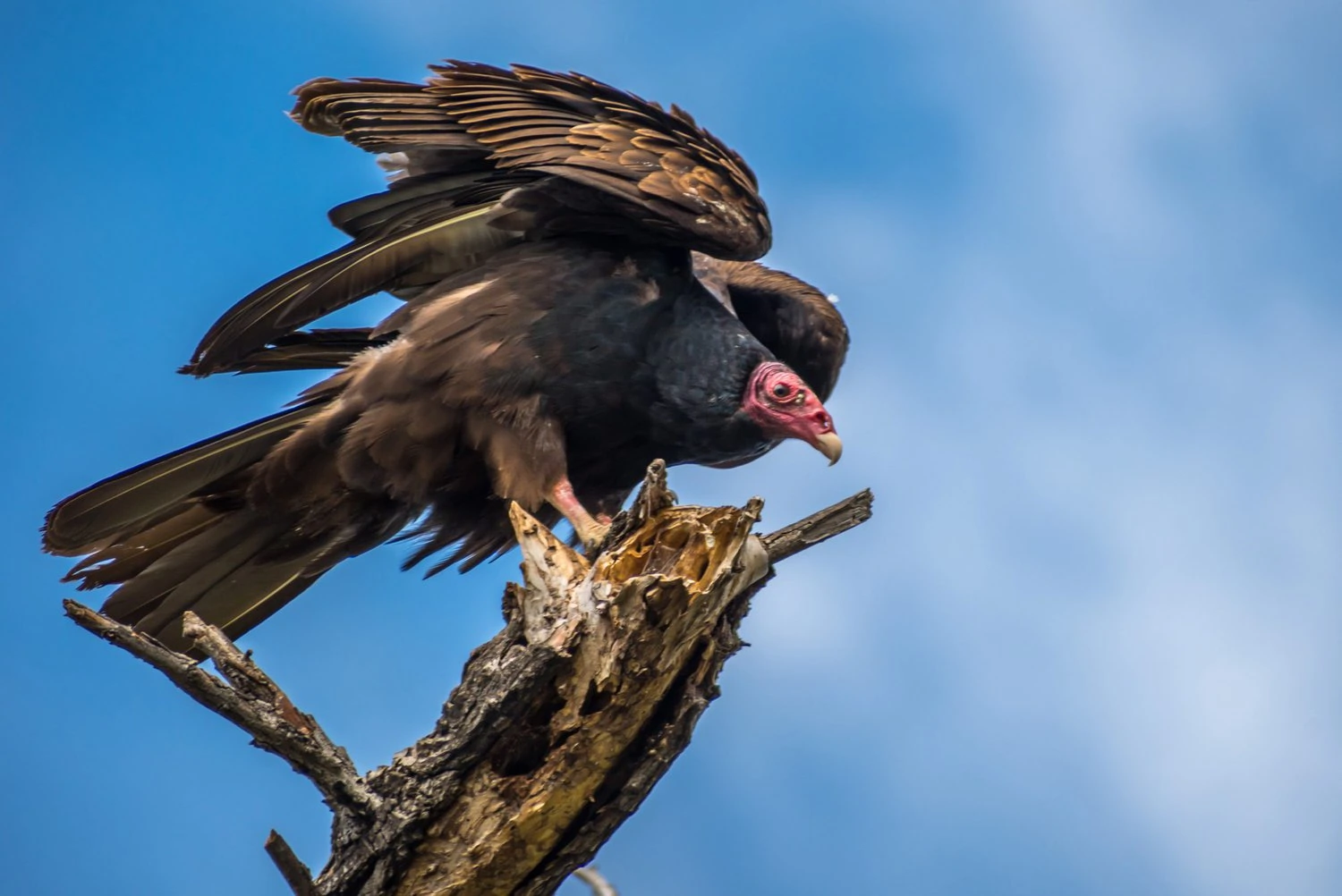
Turkey Vultures are usually found in New Brunswick during the breeding season, but some also stay all year. They are recorded in 3% of summer checklists.
Turkey Vultures are aptly named. They do look like turkeys with their big, bald, red heads and upper necks and brownish-black bodies. However, they are larger than turkeys, and when they’re in flight, their broad wings are slightly raised and make a “V”.
Under their wings, they have gray coloring, making it seem like they’re two-toned. Their eyes are dark brown, and their bills are light-colored.
- Cathartes aura
- Length: 26 – 32 in (66 – 81 cm)
- Weight: 51.2 oz (1451 g)
- Wingspan: 68 – 72 in (173 – 183 cm)
You can find Turkey Vultures in a wide range of habitats, but the most common is open and semi-open areas next to woodlands.
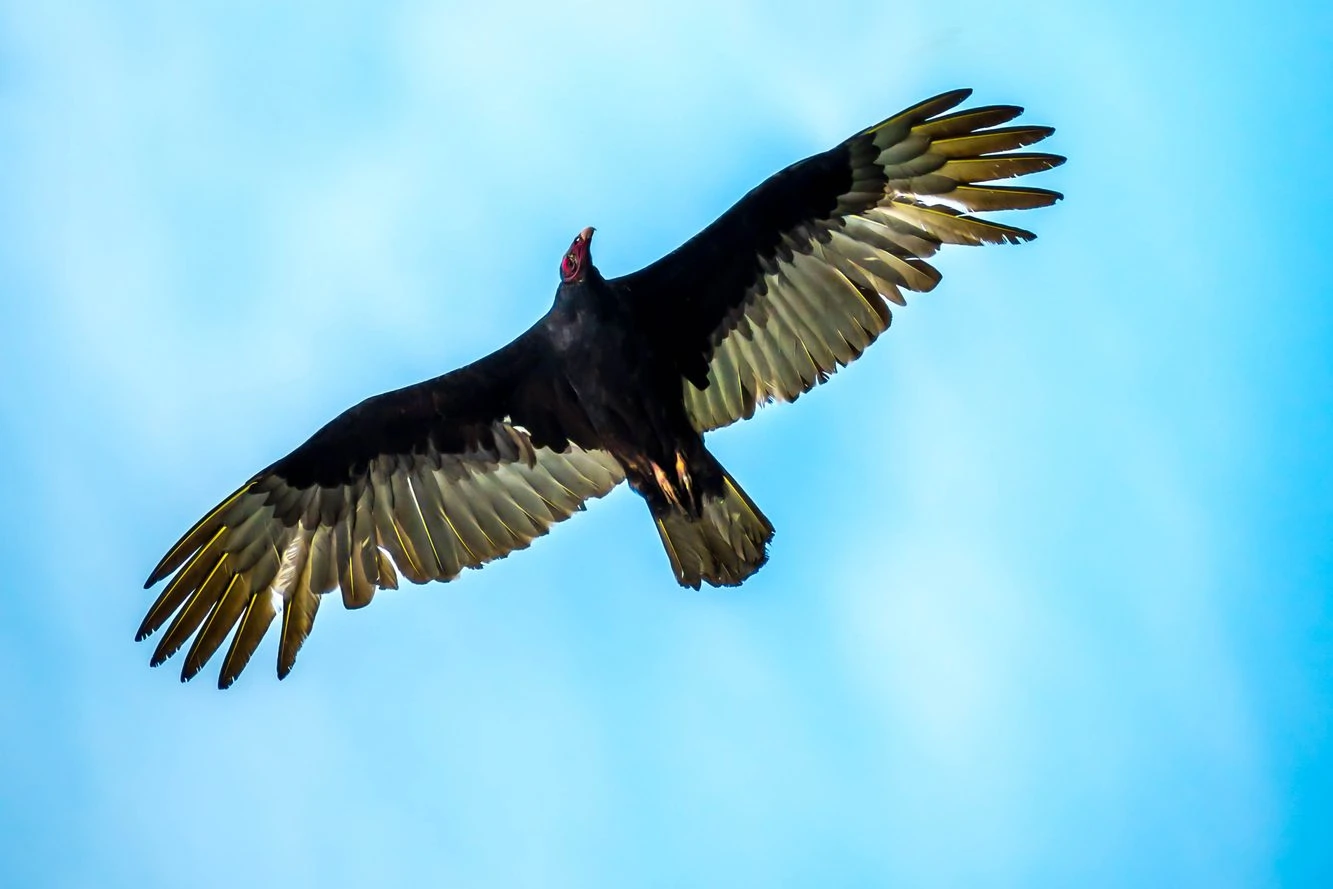
Turkey Vultures’ main source of food is carrion or recently dead or decaying animals as long as it hasn’t decayed too much. They may feed on roadkill and washed-up fish and may even kill small or weak animals.
Turkey Vultures calls: They can only make a raspy hissing sound, but are usually silent.
Fun Facts: When Turkey Vultures are threatened or aggravated, they will vomit to provide a distraction and fly away. They may even pretend to be dead.
15. Rough-legged Hawk
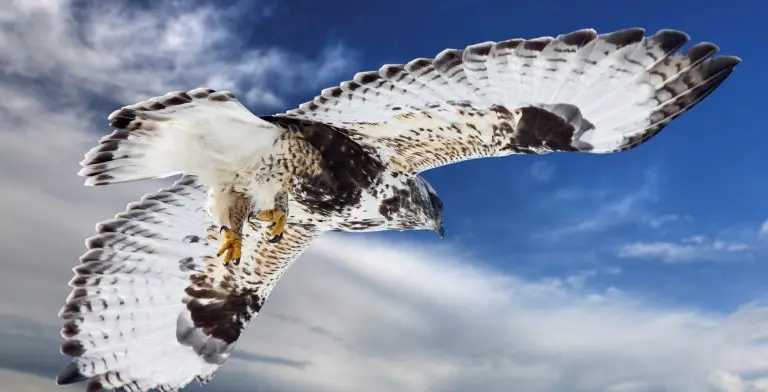
In winter, Rough-legged Hawks are the second most frequently spotted hawks in New Brunswick and appear in 1% of checklists. They are most likely to be seen during winter, from October to April. Then they fly back to their arctic breeding grounds.
The feathered legs of the Rough-legged Hawks give them their name and help to keep them warm in the arctic. They are fairly large hawks, between the size of a crow and a goose.
This predominantly dark-brown species occurs in light and dark forms, with dark patches at the bend of the wing, end of their tails, and across the belly. They have broad wings that are relatively long and narrow compared to other hawks.
- Length: 18.5-20.5 in (47-52 cm)
- Weight: 25.2-49.4 oz (715-1400 g)
- Wingspan: 52.0-54.3 in (132-138 cm)
Rough-legged Hawks breed in Alaska and northern Canada before migrating to the US for winter. They are usually sighted hovering over marshes and open fields or perched on a pole.
Lemmings and voles provide most of the prey for Rough-legged Hawks. Voles, mice, ground squirrels, and other small mammals provide winter prey in states such as West Virginia.
16. Gyrfalcon
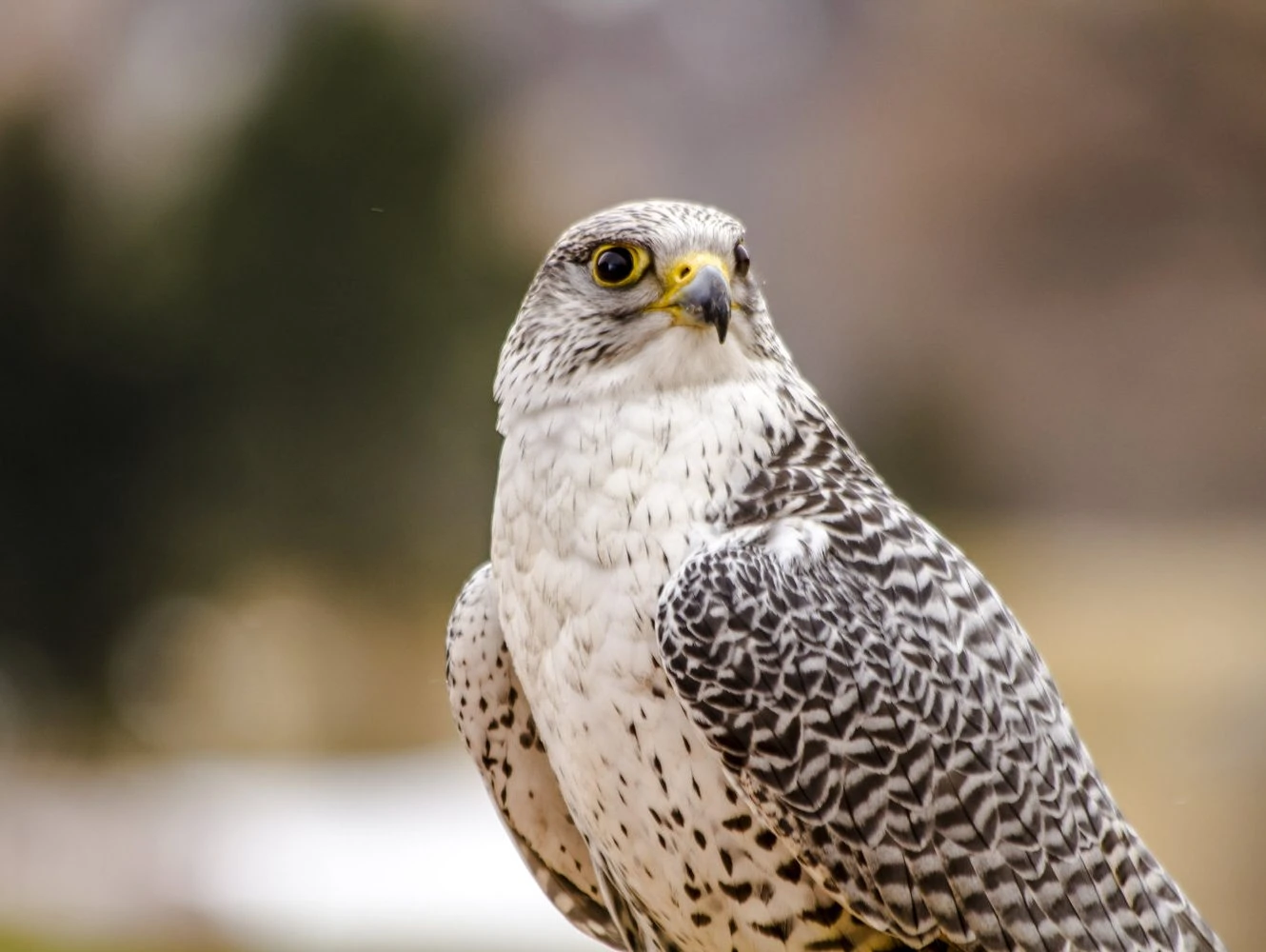
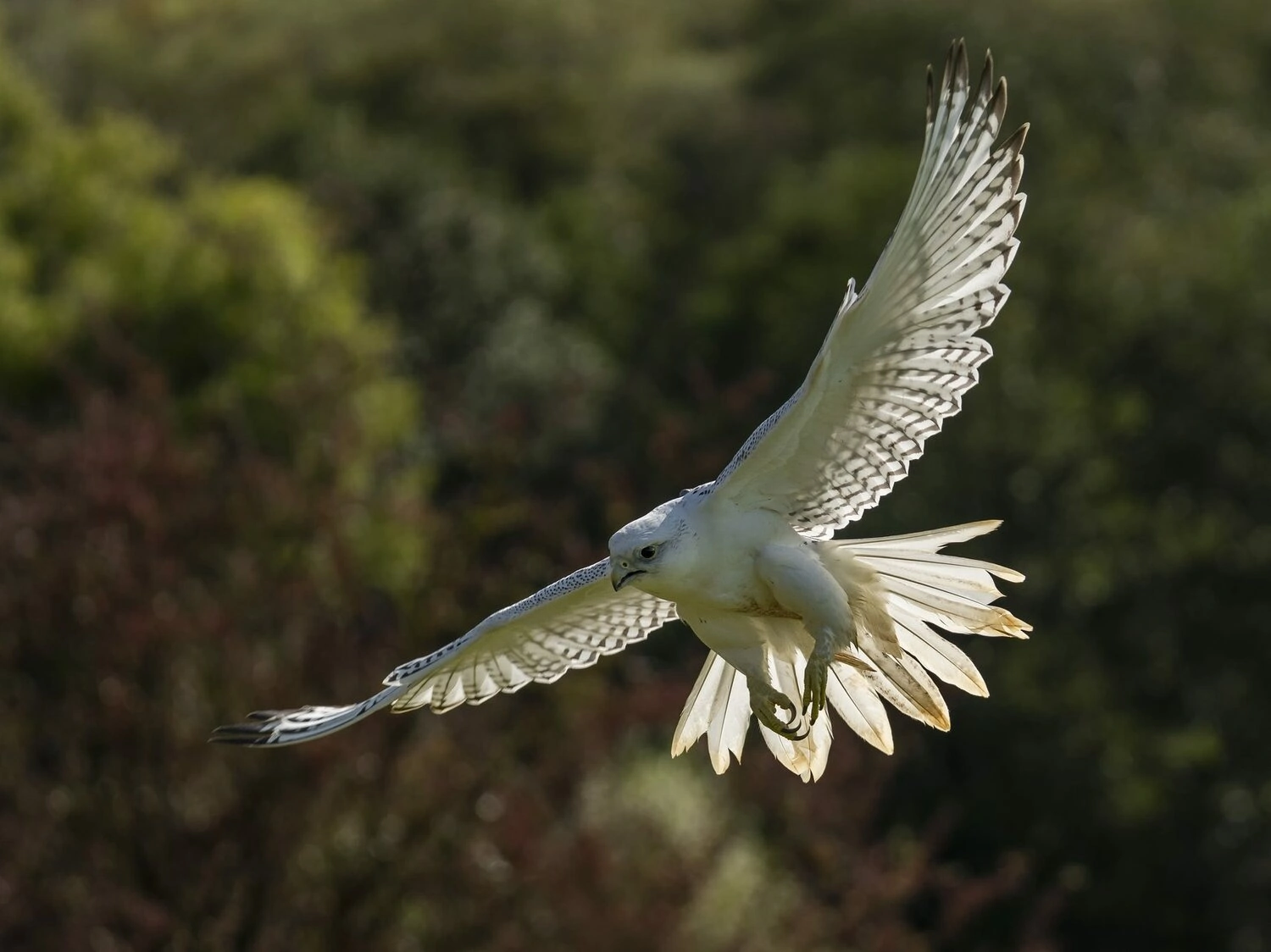
Gyrfalcons have occasionally been spotted in New Brunswick during winter but they are not very common here.
Gyrfalcons are the largest Falcons and are apex predators of the Arctic, where they snatch birds from the sky or dive at great speed to catch unsuspecting prey from the ground.
Their coloring varies greatly but generally, they have three morphs – white, silver/gray, and dark. Silver/gray is most common in North America
The silver/gray morphs are heavily banded gray and white on their upperparts but some are mostly gray without obvious banding. Their underparts are evenly spotted and white at the throat. Juveniles have solid dark heads and are browner overall.
- Falco rusticolus
- Length: 20 – 25 in (51 – 64 cm)
- Weight: 41.6 oz (1179 g)
- Wingspan: 48 – 64 in (122 – 163 cm)
Gyrfalcons are found predominantly in the arctic and sub-arctic around the world. Those that breed in the high arctic of Canada migrate to the rest of Canada and into the United States for winter.
You can find Gyrfalcons in one of the harshest places on earth, the arctic tundra. They usually stay on cliffs near shorelines or rivers and with a vast open space where they can easily hunt prey.
Gyrfalcon Call:
Fun Fact: When the chicks aren’t able to finish off their meal, the female Gyrfalcon will keep or store their leftovers behind some vegetation to retrieve later.
17. Pileated Woodpecker
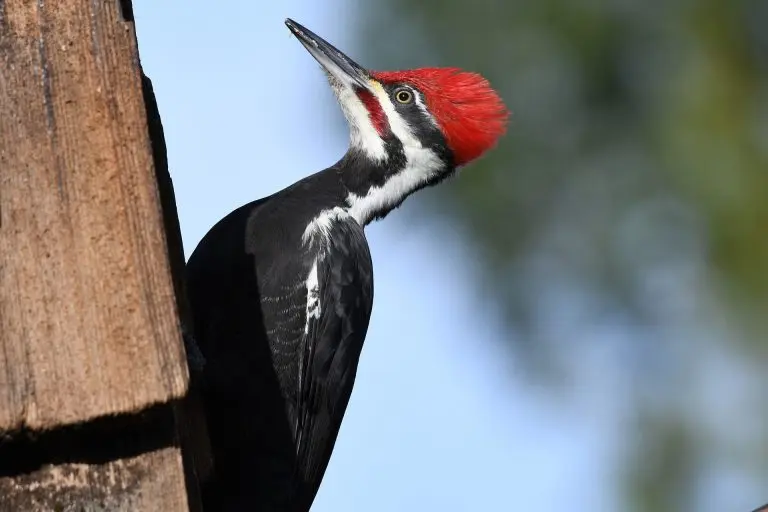
Pileated Woodpeckers do not migrate and are found in New Brunswick all year. They are spotted in 3% of summer and winter checklists.
The Pileated Woodpecker is the biggest Woodpecker in North America, and with its’ flaming-red triangular crest, it is very striking.
It is one of the biggest woodpeckers being nearly the size of a crow. It is mostly black with a white stripe, and when flying, the white underside of the wings can be seen. Males have an additional red stripe on the cheek.
Length: 15.8-19.3 in (40-49 cm)
Weight: 8.8-12.3 oz (250-350 g)
Wingspan: 26.0-29.5 in (66-75 cm)
They live all year in Eastern US states, across Canada, and into Northwestern US states.
You can find Pileated Woodpeckers in mature forests or drowned forests with lots of dead trees, but they also visit backyard feeders, especially for suet. They make distinctive rectangular holes in trees, so look out for these.
Pileated Woodpeckers mostly eat carpenter ants from dead trees and fallen logs, but they also eat beetle larvae, termites, and other insects as well as fruit and nuts such as blackberries, sumac berries, dogwood, and elderberry.
Pileated Woodpecker call and drumming:
Pileated Woodpeckers’ drum is loud and booming due to their size. They also make a ‘wuk-wuk-wuk’ call and one that sounds like laughing.
Largest Birds In New Brunswick By Weight
- Wild Turkey – 381 ounces
- American White Pelican – 246.4 ounces
- Canada Goose – 230.1 ounces
- Bald Eagle – 168 ounces
- Golden Eagle – 160 ounces
- Sandhill Crane – 132.3 ounces
- Great Cormorant – 130.5 ounces
- Great Blue Heron – 128 ounces
- Snowy Owl – 104.1 ounces
- Great Horned Owl – 88.2 ounces
- Great Black-backed Gull – 64 ounces
- Osprey – 63.5 ounces
- Great Egret – 60 ounces
- Turkey Vulture – 51.2 ounces
- Rough-legged Hawk – 49.4 ounces
- Gyrfalcon – 41.6 ounces
- Pileated Woodpecker – 12.3 ounces
Largest Birds In New Brunswick By Length
- American White Pelican – 63 inches
- Great Blue Heron – 52 inches
- Sandhill Crane – 48 inches
- Wild Turkey – 45 inches
- Canada Goose – 45 inches
- Bald Eagle – 43 inches
- Great Egret – 41 inches
- Golden Eagle – 38 inches
- Great Cormorant – 35.4 inches
- Turkey Vulture – 32 inches
- Great Black-backed Gull – 31 inches
- Snowy Owl – 27.9 inches
- Gyrfalcon – 25 inches
- Great Horned Owl – 24.8 inches
- Osprey – 24 inches
- Rough-legged Hawk – 20.5 inches
- Pileated Woodpecker – 19.3 inches
Largest Birds In New Brunswick By Wingspan
- American White Pelican – 110 inches
- Bald Eagle – 96 inches
- Golden Eagle – 96 inches
- Sandhill Crane – 90 inches
- Great Blue Heron – 82 inches
- Canada Goose – 75 inches
- Turkey Vulture – 72 inches
- Osprey – 72 inches
- Great Black-backed Gull – 65 inches
- Gyrfalcon – 64 inches
- Great Cormorant – 63 inches
- Snowy Owl – 57.1 inches
- Great Horned Owl – 57.1 inches
- Wild Turkey – 56.7 inches
- Great Egret – 55 inches
- Rough-legged Hawk – 54.3 inches
- Pileated Woodpecker – 29.5 inches

